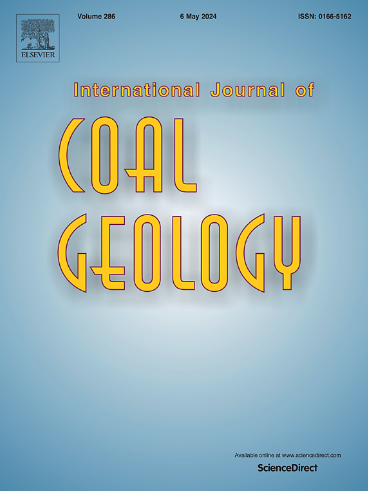The role of geological fluids on the distribution of lithium in anthracite, an example from the Yangquan Mining District, Qinshui Basin, northern China
IF 5.7
2区 工程技术
Q2 ENERGY & FUELS
引用次数: 0
Abstract
Coal with abundant kaolinite and illite has become an important target for the exploration of potential coal-hosted lithium deposits. The No.15 coal from the Xinjing Mine, northern China, is rich in kaolinite, illite, and NH4-illite. This study comprehensively applied multi-scale mineral analysis and in-situ micro-regional characterization methods to analyze the lithium content distribution in clay minerals, while elucidating the genetic mechanisms of clay minerals and their interactions with geological fluids. The genesis of these minerals and their interaction with geological fluids during thermal evolution were analyzed using whole-rock and in-situ geochemical methods. Lithium is enriched in the No.15 coal (42.2 μg/g). The Li concentration in clay minerals in the No.15 coal seam follows a descending order of: cryptocrystalline kaolinite (649.9 μg/g) > detrital kaolinite (366.1 μg/g) > cell-filling kaolinite (94.8 μg/g) > illite (16.1 μg/g) and NH4-illite (21.1 μg/g). Cryptocrystalline and detrital kaolinite are thus the primary hosts of Li. Whole-rock and mineral geochemical data indicate detrital input as the main source of Li. The similarities in the REE distribution patterns between kaolinite in coal and Yinshan granite suggest that kaolinite, a key weathering product of acidic magmatic rocks in humid sedimentary systems, may have originated from the Yinshan Mountain granite. The presence of seawater and organic acids within coal-bearing strata collectively facilitate the illitization of kaolinite at temperatures of 120–140 °C. The negative correlation between Gd anomalies and Sr/Ba ratios indicates that the interaction between groundwater and seawater has established a geochemical barrier, which facilitates the enrichment of Li in coal.
地质流体对无烟煤中锂分布的影响——以沁水盆地阳泉矿区为例
含丰富高岭石和伊利石的煤已成为寻找煤型锂矿床的重要目标。新京矿15号煤富含高岭石、伊利石和nh4伊利石。综合应用多尺度矿物分析和原位微区域表征方法,分析黏土矿物中锂含量分布,阐明黏土矿物的成因机制及其与地质流体的相互作用。采用全岩和原位地球化学方法分析了这些矿物的成因及其在热演化过程中与地质流体的相互作用。15号煤富集锂(42.2 μg/g)。15号煤层黏土矿物中Li含量由高到低依次为:隐晶高岭石(649.9 μg/g) >;碎屑高岭石(366.1 μg/g) >;充细胞高岭石(94.8 μg/g) >;伊利石(16.1 μg/g)和nh4 -伊利石(21.1 μg/g)。隐晶高岭石和碎屑高岭石是锂的主要寄主。全岩和矿物地球化学资料表明,碎屑输入是主要的Li来源。煤中高岭石与阴山花岗岩稀土元素分布模式的相似性表明,高岭石可能起源于阴山花岗岩,是湿润沉积体系酸性岩浆岩的重要风化产物。在120 ~ 140℃的温度下,含煤地层中海水和有机酸的存在共同促进了高岭石的非石化作用。Gd异常与Sr/Ba比值呈负相关,说明地下水与海水的相互作用形成了地球化学屏障,有利于煤中Li的富集。
本文章由计算机程序翻译,如有差异,请以英文原文为准。
求助全文
约1分钟内获得全文
求助全文
来源期刊

International Journal of Coal Geology
工程技术-地球科学综合
CiteScore
11.00
自引率
14.30%
发文量
145
审稿时长
38 days
期刊介绍:
The International Journal of Coal Geology deals with fundamental and applied aspects of the geology and petrology of coal, oil/gas source rocks and shale gas resources. The journal aims to advance the exploration, exploitation and utilization of these resources, and to stimulate environmental awareness as well as advancement of engineering for effective resource management.
 求助内容:
求助内容: 应助结果提醒方式:
应助结果提醒方式:


